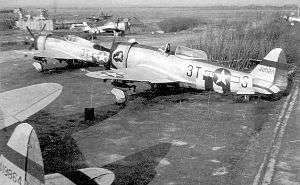XXIX Tactical Air Command
| XXIX Tactical Air Command | |
|---|---|
|
Republic P-47Ds of the 22d Fighter Squadron, 36th Fighter Group | |
| Active | 1943-1945 |
| Country | United States |
| Branch | United States Army Air Forces |
| Role | Fighter command and control |
The XXIX Tactical Air Command (XXIX TAC) is an inactive United States Air Force unit. Its last assignment was with the Ninth Air Force, based at Weimar, Germany. It was inactivated on 25 October 1945.
During World War II, the mission of the command was to support the United States Ninth Army with tactical air support throughout its easterly advance from its formation on 5 September 1944, until VE-Day.
History
The unit was formed in England during 1943 as XXIX Air Support Command (IX ASC). The primary mission of the command was to provide tactical close air support of the United States Ninth Army ground forces to interdict concentration of enemy forces, attack communications and ammunition dumps, and harass the enemy's retreat as well as providing reconnaissance to bombing support.
It was re-designated as XXIX Tactical Air Command (XXIX TAC) in April 1944 in England, and its mission initially was attacking enemy forces in occupied France and the Low Countries in preparation for the Normandy invasion in June. Targets included bridges, roads, railroads and enemy interceptor aircraft both on the ground as well as in air-to-air combat.
The unit was deployed to France in July 1944, and initially supported First and Third Army units while Ninth Army built up forces in England. When Ninth Army was moved into France in early September, the command provided tactical air support in the final reduction of the German forces holding out in the French port of Brest. After the surrender of the town fifteen days later, Ninth Army was sent east to take its place in the line. It came into the line in between Third and First Army.
In November, Ninth Army was shifted to the very left flank of 12th Army Group. It undertook operations to close the front up to the Roer River. December 16 saw the opening of the last great German offensive of the war, the Battle of the Bulge. During the fierce combat, it attacked enemy targets in the Northern Rheinland during the Rhineland Campaign and Operation Grenade, which was the southern prong of a pincer attack coordinated with Canadian First Army's Operation Veritable, with the purpose of closing the front up to the Rhine River. By 10 March, the Rhine had been reached in all sectors of Ninth Army's front. It was not until after 20 March that Ninth Army units first crossed the Rhine itself.
XXIX Tactical Air Command attacked ground targets in the Ruhr, providing air support as Allied ground forces encircled enemy forces in the Ruhr pocket, essentially ending organized enemy resistance in Western Germany. Ninth Army halted its advance at the Elbe River in late April 1945, the wing engaging targets of opportunity in enemy-controlled areas until combat was ended on 5 May 1945.
The unit remained in Europe after the war as part of United States Air Forces in Europe, performing occupation duty and the destruction or shipment to the United States of captured enemy combat equipment. It was demobilized in Germany and the organization was inactivated on 20 November 1945.
Lineage
- Constituted as XXIX Air Support Command on 1 November 1943
- Activated on 30 November 1943
- Redesignated XXIX Tactical Air Command on 15 December 1944
- Inactivated on 20 November 1945
- Disbanded on 8 October 1948
Assignments
- Ninth Air Force, 30 November 1943 – 20 November 1945
Components
|
|
Stations
|
References
![]() This article incorporates public domain material from the Air Force Historical Research Agency website http://www.afhra.af.mil/.
This article incorporates public domain material from the Air Force Historical Research Agency website http://www.afhra.af.mil/.
- Maurer, Maurer (1983). Air Force Combat Units Of World War II. Maxwell AFB, Alabama: Office of Air Force History. ISBN 0-89201-092-4.
- Johnson, David C. (1988), U.S. Army Air Forces Continental Airfields (ETO), D-Day to V-E Day; Research Division, USAF Historical Research Center, Maxwell AFB, Alabama.

.svg.png)